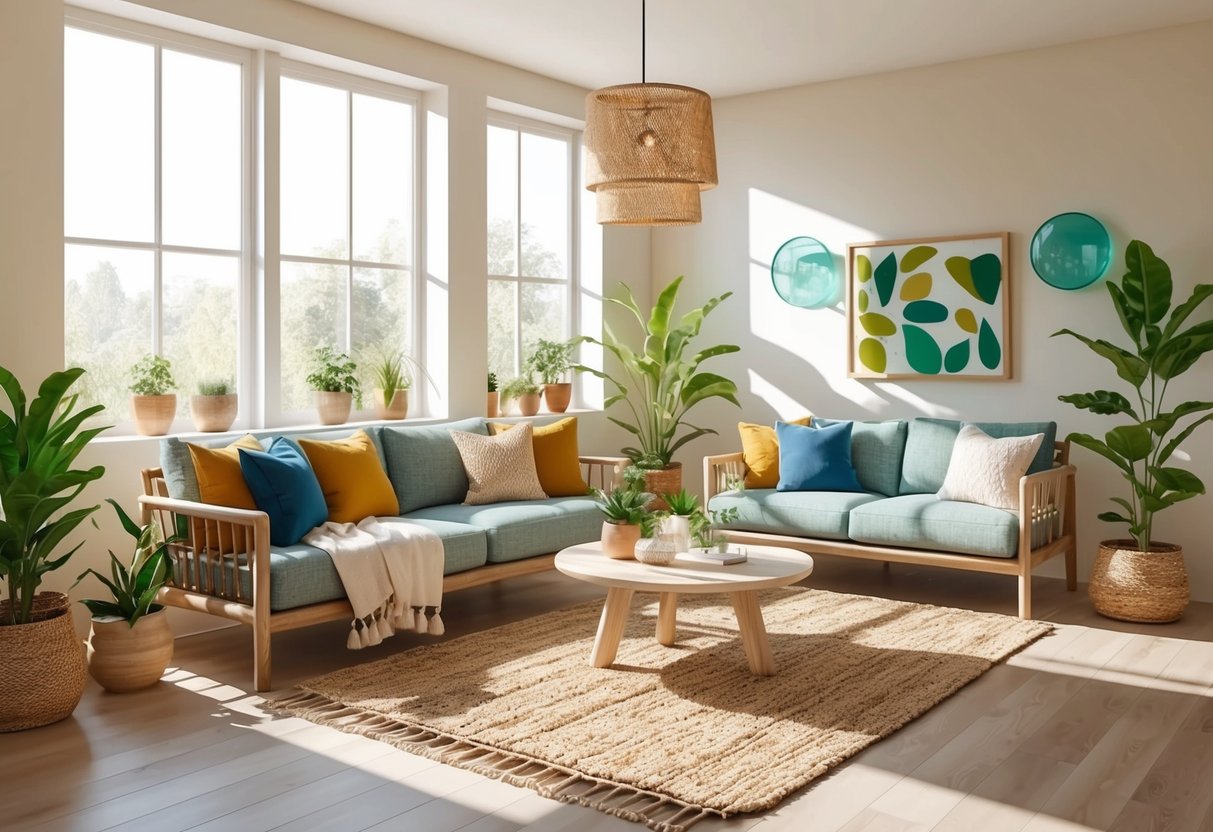
Incorporating Recycled and Upcycled Decor Elements
Choosing decor made from recycled materials and creatively upcycled items supports eco-friendly interior design while reducing landfill waste. Using objects with recycled content or repurposed origins can result in distinctive living spaces that reflect sustainable values.
Recycled Glass and Metals
Decor accents made from recycled glass and metals offer a blend of style and sustainability. Recycled glass vases, bowls, or light fixtures add visual interest and often feature unique textures or colors due to the reuse process.
Steel and aluminum made from recycled sources require less energy to produce than virgin metals, lowering the overall environmental footprint. Lighting, mirrors, and hardware made from reclaimed metal can bring an industrial yet refined element into any eco-friendly living environment.
These pieces are often durable and come in classic or modern designs. When possible, shoppers should look for certification labels that ensure materials are genuinely recycled and handled responsibly.
Using recycled glass and metals not only conserves resources but also supports companies focused on sustainable manufacturing practices. For further details, explore information about using recycled glass and metals in home decor.
Decor with Recycled Content
Selecting decor with significant recycled content helps divert waste from landfills and encourages circular material use. Pillows and rugs with recycled polyester or natural fiber blends often offer the same comfort and durability as those made from new materials.
Picture frames, tiles, and wall art crafted with recycled paper, plastics, or wood provide both style and environmental value. Labels such as “post-consumer recycled” or “reclaimed” highlight products that reduce the need for newly sourced raw materials.
These items can range from small decorative objects to large furniture pieces, such as coffee tables or shelving made from reclaimed timber. Consumers can increase their impact by choosing brands that make their recycled content percentages clear and avoid greenwashing.
Explore more tips on finding sustainable home decor with recycled content.
Creative Upcycling for Unique Design
Upcycling transforms discarded materials into distinctive new pieces, promoting creativity and minimizing waste. For example, old doors can be converted to tables, and vintage suitcases become storage or side tables.
Pallet wood can be upcycled into wall paneling or custom headboards, blending resourcefulness with function. The possibilities for creative upcycling are vast, allowing individuals to personalize their space with items that tell a story and enhance eco-friendly living.
Projects can range from DIY lamp bases made out of glass bottles to shelving crafted from old ladders or crates. This approach supports sustainability by prolonging the life of materials and encourages skilled craftsmanship.
For practical ideas and inspiration, see this collection of upcycling ideas for home decor.
Eco-Friendly Paints and Finishes
Choosing eco-friendly paints and finishes plays a crucial role in reducing indoor air pollution and improving indoor air quality. High-performance alternatives like low-VOC paints and natural finishes offer safer, healthier options that modern homeowners can rely on.
Low-VOC and No-VOC Paint Options
Low-VOC (volatile organic compounds) and no-VOC paints are specifically formulated to emit minimal chemicals into the air. Standard paints can contain VOCs that contribute to indoor air pollution, releasing strong odors and potentially causing health problems.
By using low-VOC or no-VOC paints, homeowners can help maintain improved indoor air quality for families and pets. Many well-known brands now offer a range of eco-friendly paint options in various finishes and colors.
Popular choices include water-based acrylics and paints certified by third parties for green standards. Other benefits include faster drying times and reduced lingering odors.
For more information on the best types available for a healthy home, see this guide to sustainable paint color trends.
These environmentally conscious paints are especially ideal for bedrooms, nurseries, and high-traffic spaces. Selecting paints with zero or low VOCs is one of the simplest ways to create a safer home environment.
Natural and Eco-Friendly Finishes
Natural finishes further reduce exposure to synthetic chemicals. These products commonly use ingredients like beeswax, linseed oil, clay, or plant-based resins.
Such finishes are biodegradable, non-toxic, and typically low in allergens. Natural options are available for wood, walls, and floors, offering authentic textures and subtle, elegant looks.
They’re a favorite among homeowners seeking both eco-friendly materials and timeless aesthetics. Reclaimed wood and bamboo are often paired with natural oils and waxes for a wholesome finish, as noted in this guide to sustainable home decor materials.
Using these alternatives not only safeguards health but also promotes responsible sourcing and waste reduction. They add character to interiors without compromising indoor air quality.